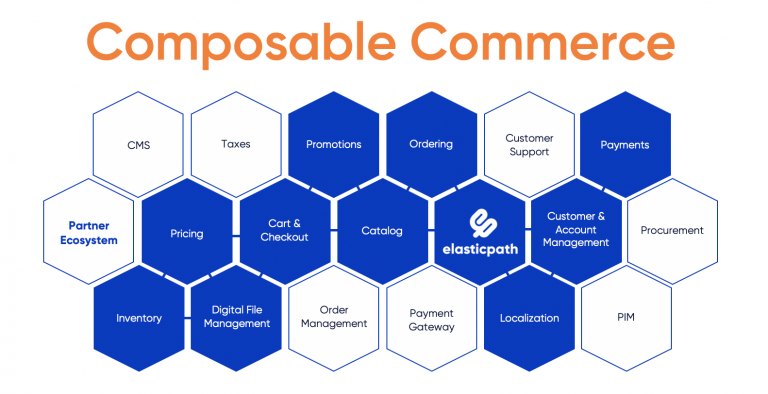Gone are the days of being locked into rigid, monolithic e-commerce platforms. Today’s savvy brands are demanding a more flexible and customizable solution – and that’s where Composable Commerce comes in.
Think of it like building your own dream car. Instead of settling for a pre-configured model, you get to pick and choose the exact engine, transmission, wheels, and interior features that perfectly suit your needs and preferences. That’s the power of Composable Commerce.
This revolutionary approach allows you to mix and match best-of-breed components from different vendors, creating a truly unique and personalized shopping experience for your customers. No more limitations, no more compromises – just the freedom to build the e-commerce platform you’ve always dreamed of.
Stats Overview of Composable Commerce
- 72% of US retailers are already using composable commerce in some manner, and another 21% plan to adopt it within the next year. (Source: Insiderintelligence)
- 95% of e-commerce practitioners surveyed believe composable commerce is the best approach businesses should take. (Source: zoovu)
- The global composable commerce market is expected to grow from $5.2 billion in 2023 to $11.8 billion by 2028, at a CAGR of 17.5%. (Source: marketsandmarkets)
Key benefits of composable commerce
Flexibility:
Forget the days of being stuck with a rigid, one-size-fits-all e-commerce platform. Composable Commerce empowers you to mix and match best-of-breed components from different vendors, creating a bespoke platform that perfectly reflects your brand and delivers a seamless shopping experience for your customers. Need a new payment gateway? Just plug it in! Want to add a personalized product recommendation engine? No problem! The possibilities are endless.
Agility:
In today’s fast-paced world, businesses need to be able to respond to changing trends and customer expectations quickly. Composable Commerce gives you the agility you need to stay ahead of the curve. With a modular architecture, you can easily add, remove, or update components without having to overhaul your entire platform. This means you can experiment with new features and functionalities, launch marketing campaigns on a dime, and adapt to unforeseen circumstances with ease.
Customization:
Say goodbye to generic, cookie-cutter online experiences. Composable Commerce allows you to tailor your e-commerce platform to your specific needs and brand identity. From the look and feel of your website to the checkout process and customer service experience, everything can be customized to create a truly unique and memorable shopping journey for your customers. This level of personalization can lead to increased brand loyalty, higher conversion rates, and a more engaged customer base.
Composable commerce architecture

Source: firebearstudio
Microservices:
Imagine your e-commerce platform as a complex machine. In traditional monolithic architectures, this machine is a tightly coupled unit, with all the components working together as a single entity. Composable commerce, on the other hand, embraces the concept of microservices. This means breaking down your platform into smaller, independent components, each with its own specific function.
Each microservice is responsible for a single task, such as product management, order processing, or customer service. This modular approach offers several advantages:
Increased flexibility:
You can easily add, remove, or update individual microservices without affecting the rest of the platform.Improved scalability:
Each microservice can be scaled independently to handle increased demand.Enhanced resilience:
If one microservice fails, the others can continue to function, minimizing downtime and disruptions.
APIs:
Microservices communicate with each other through APIs (Application Programming Interfaces). APIs act as messengers, allowing different components to share data and functionality. This ensures that your platform remains cohesive and operates smoothly, even with a complex microservices architecture.
Headless Commerce:
Headless commerce is a key component of composable commerce. It separates the front-end (the user interface) from the back-end (the data and logic). This gives you complete control over the look and feel of your online store, while still utilizing powerful back-end features from various vendors.
Containerization:
Containers are standardized units of software that package code and all its dependencies together. This makes it easier to deploy, manage, and scale microservices across different environments.
MACH Architecture:
The MACH architecture (Microservices, API-first, Cloud-native, and Headless) is a set of principles that guide the development of composable commerce platforms. By adhering to these principles, you can ensure that your platform is flexible, scalable, and future-proof.
Choosing E-Commerce: Composable or Traditional?
Monolithic Platforms: A Tightly-Coupled System
Imagine a monolithic platform as a giant, self-contained building. Everything – the walls, the roof, the furniture – is all built together as one unit. This approach was the standard for e-commerce platforms for many years, offering a unified experience but lacking flexibility.
Here are some key characteristics of monolithic platforms:
Single codebase:
All the code for the platform is contained within a single application.Tightly coupled components:
All components of the platform are interconnected and interdependent.Limited customization:
It’s difficult to customize the platform to meet specific needs.Scalability challenges:
Scaling the platform often requires significant infrastructure upgrades.Vendor lock-in:
Businesses are often locked into a single vendor for all their platform needs.
Composable Commerce: Breaking Down the Walls
Now, imagine a building where each room is a separate module, independently constructed and connected through standardized interfaces. This is the essence of composable commerce.
Here are some key characteristics of composable commerce platforms:
Microservices architecture:
The platform is comprised of independent microservices, each responsible for a specific function.API-first approach:
Microservices communicate with each other through APIs, allowing for flexibility and integration.Headless commerce:
The front-end (presentation layer) is decoupled from the back-end (business logic), enabling greater customization.Cloud-native:
The platform is designed to be deployed and managed in the cloud, offering scalability and agility.Vendor-agnostic:
Businesses can choose best-of-breed solutions from multiple vendors.
Key differences
| Feature | Monolithic Platforms | Composable Commerce |
| Architecture | Single codebase, tightly coupled | Microservices, API-first, headless, cloud-native |
| Flexibility | Limited | High |
| Customization | Difficult | Extensive |
| Scalability | Scalable with effort | Highly scalable |
| Vendor lock-in | High | Low |
| Cost | Lower upfront cost | Higher initial investment |
| Complexity | Lower complexity | Higher complexity |
Monolithic platforms may be suitable for businesses with:
- Simple e-commerce needs
- Limited customization requirements
- Tight budgets
- Low technical expertise
Composable commerce platforms may be ideal for businesses with:
- Complex e-commerce needs
- High customization requirements
- Scalability needs
- Strong technical expertise
- A desire for flexibility and agility
Top Reasons for Composable Commerce
Increased Conversion Rates:
- By delivering personalized and seamless customer experiences, composable commerce can boost conversion rates by up to 20%. (Source: Salesforce State of Commerce Report 2023 )
- Microservices-based architecture allows for faster loading times and smoother user experiences, further contributing to higher conversion rates.
Higher Average Order Values:
- Personalization and targeted recommendations enabled by composable commerce can lead to increased basket sizes and higher average order values. (Source: McKinsey & Company, The State of Fashion 2023)
- Businesses can offer product bundles and personalized offers, driving higher average spending per customer.
Reduced Operational Costs:
- Composable commerce eliminates the need for costly platform upgrades and vendor lock-in.
- Microservices architecture allows for easier maintenance and scalability, reducing operational costs.
Improved Time to Market:
- Modular architecture and API-first approach enable faster development and deployment of new features and functionalities.
- Businesses can experiment more quickly and adapt to changing market trends with agility.
Greater Agility and Responsiveness:
- Composable commerce enables businesses to react swiftly to changing market conditions and customer demands.
- Microservices architecture allows for independent development and deployment of new features, ensuring flexibility and responsiveness.
Enhanced Personalization:
- Composable commerce empowers businesses to personalize the customer journey across all touchpoints.
- Microservices architecture allows for integration with various tools and data sources to create unique and personalized experiences.
Seamless Omnichannel Experiences:
- Composable commerce provides a consistent and unified experience across all channels, from online stores to mobile apps and physical stores.
- Microservices architecture allows for smooth integration with various systems and platforms, facilitating a seamless omnichannel experience.
Quick and Easy: Starting with Composable Commerce
Assess Your Needs and Define Your Goals:
Analyze your current e-commerce landscape:
Identify strengths, weaknesses, and areas for improvement.Define your business goals:
What are you hoping to achieve with composable commerce? (e.g., increased conversion rates, personalized experiences, improved operational efficiency)Map your customer journey:
Understand the touchpoints and interactions customers have with your brand.
Conduct a Composable Commerce Audit:
Evaluate your existing architecture:
Identify the components that can be integrated into a composable platform and those requiring replacement.Assess your technical capabilities:
Determine your team’s skills and resources for implementation and maintenance.Research composable commerce solutions:
Explore different platforms and vendors based on your needs and budget.
Design Your Composable Architecture:
Choose your microservices:
Select the best-of-breed solutions for key functionalities like product management, content management, and payments.Define the APIs:
Establish clear communication protocols between different microservices.Plan for data management:
Ensure consistent data synchronization and security across different systems.
Implement and Integrate Microservices:
Start small:
Begin with a few essential microservices and gradually add more as you gain experience.Adopt a cloud-native approach:
Leverage cloud platforms for scalability, agility, and cost efficiency.Utilize integration tools and platforms:
Simplify the process of connecting different microservices.
Optimize and Iterate:
Monitor performance:
Track key metrics like conversion rates, average order value, and operational costs.Gather customer feedback:
Continuously refine your composable architecture based on customer needs and market trends.Experiment and innovate:
Don’t be afraid to try new features and functionalities to stay ahead of the curve.
Challenges of composable commerce
Complexity of Implementation:
- Composable commerce requires a well-defined architecture and a strong understanding of microservices and APIs.
- Businesses need to carefully plan and orchestrate the integration of various components.
How to overcome:
- Start small and scale gradually. Begin with a few key components and gradually add more as your team becomes comfortable with the technology.
- Seek help from experienced partners. Consult with experts who can guide you through the implementation process and help you avoid pitfalls.
- Invest in training and development. Equip your team with the necessary skills and knowledge to work effectively in a composable environment.
Integration Challenges:
- Integrating different microservices from various vendors can be complex and time-consuming.
- Data synchronization and consistency across different systems can be a challenge.
Solution:
- Choose vendors with open APIs and strong integration capabilities.
- Use standardized data formats and protocols to ensure seamless data exchange.
- Invest in robust integration tools and platforms.
Technical Expertise Required:
- Composable commerce requires a team with strong technical expertise in microservices, APIs, and cloud-native technologies.
- Businesses may need to hire additional staff or outsource some aspects of development and maintenance.
How to overcome:
- Build a team with a diverse skillset. Look for individuals with experience in microservices, APIs, and cloud technologies.
- Invest in training and development programs. Equip your existing team with the necessary skills to work in a composable environment.
- Consider outsourcing specific tasks. Partner with experienced agencies or consultants to handle complex integration or development needs.
Cost:
- Implementing and maintaining a composable architecture can be more expensive than traditional platforms.
- Businesses need to factor in the cost of additional software, hardware, and technical expertise.
To overcome:
- Start with an MVP (Minimum Viable Product) and scale gradually. This will help you minimize upfront costs and ensure you’re investing in the right solutions.
- Choose cost-effective solutions. Look for open-source platforms and vendors who offer flexible pricing models.
- Consider the long-term benefits. While the initial investment may be higher, the cost savings and increased agility gained from composable commerce can outweigh the initial expense in the long run.
Security:
- Managing security across a complex ecosystem of microservices requires additional attention.
- Businesses need to implement robust security measures to protect against potential vulnerabilities.
How to overcome:
- Choose vendors with a strong track record of security.
- Implement a zero-trust security model. This approach assumes no user or device is inherently trustworthy and requires continuous verification.
- Conduct regular security audits and penetration tests. This will help you identify and address potential vulnerabilities before they can be exploited.
Must read:
E-commerce Website Development – Step By Step Guide
Real Cases of Composable Commerce
Nike:
Challenge: Nike needed to personalize the customer experience across its global e-commerce platform, cater to diverse regional preferences, and offer a seamless omnichannel experience.
Solution: Nike implemented a composable commerce architecture, integrating best-of-breed solutions for product management, content management, and personalization.
Results: Nike saw a 20% increase in conversion rates and a 15% rise in average order value. The composable architecture also enabled faster time to market for new features and functionalities.
Sephora:
Challenge: Sephora aimed to deliver a personalized beauty shopping experience while remaining agile and responsive to changing trends and customer preferences.
Solution: Sephora adopted a composable commerce approach, integrating various microservices for product recommendations, loyalty programs, and personalized content delivery.
Results: Sephora witnessed a 30% increase in customer engagement and a 10% boost in online sales. The composable architecture also enabled them to experiment with new features and adapt to market trends more quickly.
Domino’s:
Challenge: Domino’s wanted to improve online ordering efficiency and offer a more user-friendly experience for mobile customers.
Solution: Domino’s implemented a composable commerce platform with microservices for online ordering, payment processing, and delivery tracking.
Results: Domino’s experienced a 25% decrease in online order abandonment rates and a 15% increase in mobile app orders. The composable architecture also enabled faster development and deployment of new features.
The Body Shop:
Challenge: The Body Shop needed to cater to a diverse customer base across multiple regions and personalize the online shopping experience accordingly.
Solution: The Body Shop implemented a composable commerce platform with microservices for product recommendations, content management, and regional personalization.
Results: The Body Shop witnessed a 20% increase in customer satisfaction and a 10% rise in conversion rates. The composable architecture also enabled them to tailor the online experience to specific regional preferences.
Patagonia:
Challenge: Patagonia needed to improve its e-commerce platform’s scalability and agility to accommodate its growing online business.
Solution: Patagonia adopted a composable commerce approach, leveraging microservices for product management, order processing, and inventory management.
Results: Patagonia achieved a 40% increase in online sales volume and improved operational efficiency. The composable architecture also enabled them to handle peak season traffic more effectively.
Key Points
Composable commerce represents a paradigm shift in the way businesses build and manage their e-commerce platforms. It offers unparalleled flexibility, agility, and personalization, empowering businesses to thrive in today’s dynamic digital landscape.
While the journey to composable commerce may seem daunting, it doesn’t have to be. By following the steps outlined in this blog and partnering with experienced solution providers like GeekyAnts, you can navigate this transformation smoothly and unlock the full potential of composable commerce.
GeekyAnts’ expertise in web and app development, combined with their deep understanding of composable architecture, makes them the ideal partner for your composable commerce journey.
Contact GeekyAnts today to learn how we can help you!


















